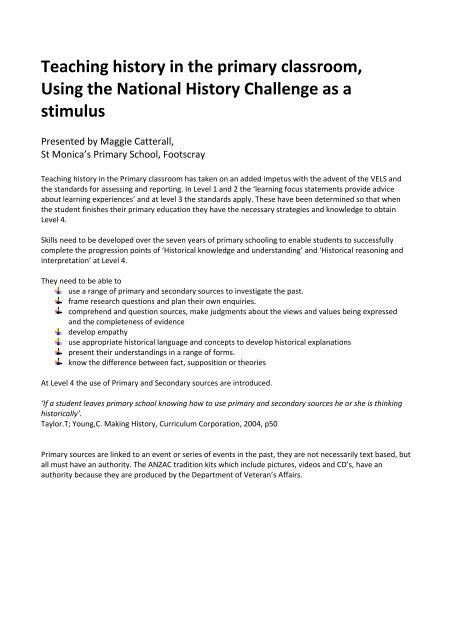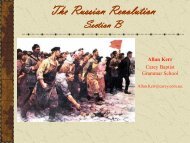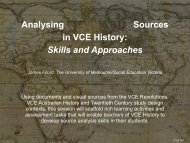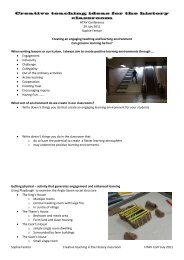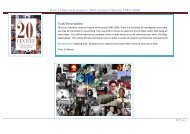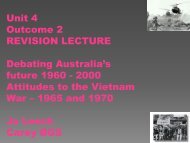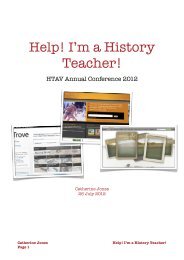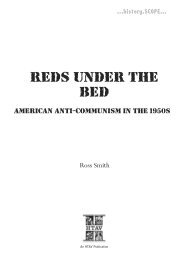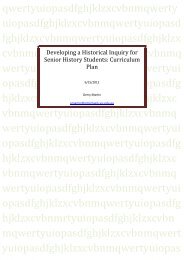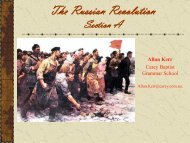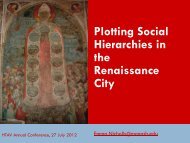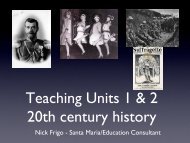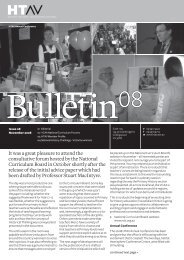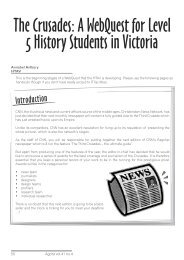Teaching history in the primary classroom, - HTAV
Teaching history in the primary classroom, - HTAV
Teaching history in the primary classroom, - HTAV
You also want an ePaper? Increase the reach of your titles
YUMPU automatically turns print PDFs into web optimized ePapers that Google loves.
<strong>Teach<strong>in</strong>g</strong> <strong>history</strong> <strong>in</strong> <strong>the</strong> <strong>primary</strong> <strong>classroom</strong>,<br />
Us<strong>in</strong>g <strong>the</strong> National History Challenge as a<br />
stimulus<br />
Presented by Maggie Catterall,<br />
St Monica’s Primary School, Footscray<br />
<strong>Teach<strong>in</strong>g</strong> <strong>history</strong> <strong>in</strong> <strong>the</strong> Primary <strong>classroom</strong> has taken on an added impetus with <strong>the</strong> advent of <strong>the</strong> VELS and<br />
<strong>the</strong> standards for assess<strong>in</strong>g and report<strong>in</strong>g. In Level 1 and 2 <strong>the</strong> ‘learn<strong>in</strong>g focus statements provide advice<br />
about learn<strong>in</strong>g experiences’ and at level 3 <strong>the</strong> standards apply. These have been determ<strong>in</strong>ed so that when<br />
<strong>the</strong> student f<strong>in</strong>ishes <strong>the</strong>ir <strong>primary</strong> education <strong>the</strong>y have <strong>the</strong> necessary strategies and knowledge to obta<strong>in</strong><br />
Level 4.<br />
Skills need to be developed over <strong>the</strong> seven years of <strong>primary</strong> school<strong>in</strong>g to enable students to successfully<br />
complete <strong>the</strong> progression po<strong>in</strong>ts of ‘Historical knowledge and understand<strong>in</strong>g’ and ‘Historical reason<strong>in</strong>g and<br />
<strong>in</strong>terpretation’ at Level 4.<br />
They need to be able to<br />
use a range of <strong>primary</strong> and secondary sources to <strong>in</strong>vestigate <strong>the</strong> past.<br />
frame research questions and plan <strong>the</strong>ir own enquiries.<br />
comprehend and question sources, make judgments about <strong>the</strong> views and values be<strong>in</strong>g expressed<br />
and <strong>the</strong> completeness of evidence<br />
develop empathy<br />
use appropriate historical language and concepts to develop historical explanations<br />
present <strong>the</strong>ir understand<strong>in</strong>gs <strong>in</strong> a range of forms.<br />
know <strong>the</strong> difference between fact, supposition or <strong>the</strong>ories<br />
At Level 4 <strong>the</strong> use of Primary and Secondary sources are <strong>in</strong>troduced.<br />
‘If a student leaves <strong>primary</strong> school know<strong>in</strong>g how to use <strong>primary</strong> and secondary sources he or she is th<strong>in</strong>k<strong>in</strong>g<br />
historically’.<br />
Taylor.T; Young,C. Mak<strong>in</strong>g History, Curriculum Corporation, 2004, p50<br />
Primary sources are l<strong>in</strong>ked to an event or series of events <strong>in</strong> <strong>the</strong> past, <strong>the</strong>y are not necessarily text based, but<br />
all must have an authority. The ANZAC tradition kits which <strong>in</strong>clude pictures, videos and CD’s, have an<br />
authority because <strong>the</strong>y are produced by <strong>the</strong> Department of Veteran’s Affairs.
Primary sources :‐<br />
Photographs<br />
Diaries<br />
Newspapers ‐ editorials, letters<br />
Pa<strong>in</strong>t<strong>in</strong>gs<br />
Interviews with person’s <strong>in</strong>volved or who lived at that time.<br />
Official Records<br />
Maps<br />
Statistics<br />
Speeches<br />
Autobiographies<br />
Internet<br />
CD’s & videos<br />
Photographs are an excellent <strong>primary</strong> source tool to <strong>in</strong>troduce a historical learn<strong>in</strong>g experience to<br />
children <strong>in</strong> <strong>the</strong> Early Years. Us<strong>in</strong>g children’s photos a story can be written about events <strong>in</strong> <strong>the</strong> past, or a<br />
storyboard created about <strong>the</strong> family. A family photo taken before <strong>the</strong> child was born, (of an event which<br />
<strong>the</strong> children would not have experienced), can give <strong>the</strong>m an understand<strong>in</strong>g of past events, places and<br />
fashion.<br />
Secondary sources are usually sources that are produced after <strong>the</strong> events such as<br />
Text books<br />
Biographies<br />
Historical Novels<br />
Non fiction books<br />
Encyclopaedias<br />
Internet<br />
Interviews with a second party<br />
It is through ga<strong>in</strong><strong>in</strong>g an understand<strong>in</strong>g of <strong>primary</strong> and secondary sources that students will develop <strong>the</strong> skill<br />
to differentiate between ‘facts’, ‘<strong>the</strong> truth’, <strong>the</strong>ories, supposition and evidence. Students need to check all<br />
sources for au<strong>the</strong>nticity and relevance. Just because it is on <strong>the</strong> Internet or written <strong>in</strong> a text book does not<br />
mean it is historically correct. Research should be checked aga<strong>in</strong>st at least 3 o<strong>the</strong>r sources for verification.<br />
The teach<strong>in</strong>g of <strong>history</strong> prior to <strong>the</strong> 80’s concentrated on students acquir<strong>in</strong>g knowledge, learn<strong>in</strong>g dates,<br />
facts, cause and effect and sequence of events. Today, we need to develop empathy ‐<strong>the</strong> ability to see and<br />
understand events from <strong>the</strong> po<strong>in</strong>t of view of <strong>the</strong> participants. Give students an understand<strong>in</strong>g of motives<br />
and reason<strong>in</strong>g beh<strong>in</strong>d past actions. Look<strong>in</strong>g at different po<strong>in</strong>ts of view develops empathy. There are many<br />
graphic organisers such as De Bono’s OPV’s(O<strong>the</strong>r people’s views ) that are excellent tools for develop<strong>in</strong>g<br />
empathy. Ned Kelly is seen as a hero, and <strong>the</strong> police <strong>the</strong> aggressor, whereas <strong>in</strong> reality Ned Kelly was a<br />
bushranger and <strong>the</strong> police had a duty to protect people and property. Understand<strong>in</strong>g <strong>the</strong> implications for<br />
<strong>the</strong> Aborig<strong>in</strong>al people when <strong>the</strong> First Settlers arrived will give a new perspective on teach<strong>in</strong>g about <strong>the</strong> First<br />
Fleet.<br />
An effective way of develop<strong>in</strong>g empathy <strong>in</strong> upper <strong>primary</strong> is to use historical fiction. While serial read<strong>in</strong>g,<br />
teachers are able to break down <strong>the</strong> text and develop <strong>the</strong> student’s deeper understand<strong>in</strong>g of how <strong>the</strong><br />
participants felt and <strong>the</strong> reasons for <strong>the</strong>ir actions.<br />
A historical language needs to be developed because language itself has <strong>history</strong>. In <strong>the</strong> WW2 blitz‐ meant<br />
bomb<strong>in</strong>g – to children today ‘ blitz’ has a different mean<strong>in</strong>g .Words like revolution, upris<strong>in</strong>g, and rebellion
are specifically historical as are past, last year, and long ago. The teacher is required to select <strong>the</strong>ir texts<br />
carefully and a specific glossary to support <strong>the</strong> text may be needed.<br />
Through all Levels it is possible to <strong>in</strong>corporate Asian and Global perspectives <strong>in</strong>to students ‘learn<strong>in</strong>g<br />
experiences’ and <strong>the</strong> teach<strong>in</strong>g of <strong>history</strong>. Level 1 are required to ‘Learn about <strong>the</strong> cultures and histories that<br />
have contributed to Australia’s <strong>history</strong>’. By Level 4 students should have an understand<strong>in</strong>g of <strong>the</strong> change<br />
and cont<strong>in</strong>uity over time of <strong>the</strong> establishment of Australia, and how our migrant population have<br />
contributed to <strong>the</strong> complex, multifaceted and evolv<strong>in</strong>g Australian identity.<br />
St Monica’s is an eLearn<strong>in</strong>g school with<strong>in</strong> <strong>the</strong> Catholic Education system, and <strong>the</strong> teach<strong>in</strong>g of <strong>history</strong> fits well<br />
<strong>in</strong>to <strong>the</strong> ‘<strong>in</strong>quiry approach’. Over <strong>the</strong> last three years students <strong>in</strong> Yr 6 have entered <strong>the</strong> National History<br />
Challenge, result<strong>in</strong>g <strong>in</strong> <strong>in</strong>dividual students w<strong>in</strong>n<strong>in</strong>g state prizes and o<strong>the</strong>rs travell<strong>in</strong>g to Canberra to receive<br />
National awards. It is a research based competition which gives students a chance to be historians, to<br />
<strong>in</strong>vestigate <strong>the</strong>ir community and explore <strong>the</strong>ir past. The Challenge emphasises and rewards <strong>the</strong> depth of<br />
<strong>the</strong>ir research and provides a vehicle to <strong>in</strong>vestigate an issue or part of <strong>history</strong> with a real purpose. Students<br />
are able to select <strong>the</strong>ir favoured method of presentation, <strong>in</strong>clud<strong>in</strong>g three dimensional dioramas and multimedia,<br />
<strong>the</strong>refore cater<strong>in</strong>g for <strong>the</strong> use of multiple <strong>in</strong>telligences and different learn<strong>in</strong>g styles.<br />
The competition lends itself to <strong>the</strong> ‘Inquiry approach’ and development of research and bibliographic skills.<br />
A Rubric is essential for <strong>the</strong> required level of presentation.<br />
In 2004 <strong>the</strong> <strong>the</strong>me was ‘Australia is a multicultural nation’. St Monica’s entered five categories. A diorama<br />
show<strong>in</strong>g that St Monica’s school <strong>history</strong> reflects <strong>the</strong> migration patterns <strong>in</strong> Australia won <strong>the</strong> State and <strong>the</strong>n<br />
<strong>the</strong> National Prize for a Museum display<br />
‘Australians All’ <strong>the</strong> <strong>the</strong>me for 2005 was applicable at Level 4 of <strong>the</strong> VELS, and we entered 7 categories. It<br />
was a perfect vehicle to <strong>in</strong>tegrate Asian Perspectives. An essay about ‘Tan Le, Young Australian of <strong>the</strong> Year<br />
1998’ won <strong>the</strong> State and <strong>the</strong>n <strong>the</strong> National prize for Asia and Australia sponsored by The Asia Education<br />
Foundation. Ano<strong>the</strong>r entry about Sir Paul Edmund de Strzelecki also won a State award. A diorama about<br />
Indigenous players <strong>in</strong> <strong>the</strong> AFL was <strong>the</strong> State Runner Up for Indigenous Australia, and we also received two<br />
Highly Commended certificates.<br />
This year every student <strong>in</strong> Year 6 participated and 9 categories were entered. The <strong>the</strong>me was ‘Turn<strong>in</strong>g<br />
po<strong>in</strong>ts,’ and we received <strong>the</strong> State prize for a website on <strong>the</strong> humanitarian endeavours of Sir Paul Edmund<br />
de Strzlecki and ano<strong>the</strong>r for <strong>the</strong> History of Sport diorama which showed <strong>the</strong> tradition of <strong>the</strong> ANZAC day<br />
match between Coll<strong>in</strong>gwood and Essendon.<br />
In 2006 Year 4 participated <strong>in</strong> <strong>the</strong> Commonwealth History project ‘Mak<strong>in</strong>g History come alive’. ‘What <strong>the</strong><br />
river saw’ is embedded <strong>in</strong> <strong>the</strong> VELS History Level 3 Discipl<strong>in</strong>e Based Learn<strong>in</strong>g Strand. The learn<strong>in</strong>g foci are ‘To<br />
<strong>in</strong>vestigate settlement patterns and land use of <strong>the</strong> banks of <strong>the</strong> Maribyrnong River, and how <strong>the</strong>y have<br />
changed over time.’<br />
A timel<strong>in</strong>e sequenced <strong>the</strong> key events and <strong>the</strong> chang<strong>in</strong>g use of <strong>the</strong> river.<br />
Taylor.T; Young,C. Mak<strong>in</strong>g History, Curriculum Corporation, Carlton South, 2004<br />
Victorian Essential Learn<strong>in</strong>g Standards, VCAA, Melbourne, 2006


